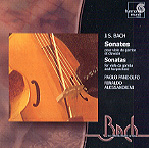Harmonia Mundi’s superb Bach Edition releases continue to remind us not only of the unsurpassed greatness of the world’s definitive musical genius, but also of what a treasure this label’s catalog is. The three sonatas for viola da gamba and obbligato harpsichord belong to the number of Bach’s works drawn and reformed from works originally written for other instruments or voices. No matter, because as usual, the transformation is substantial enough and idiomatically appropriate enough to qualify these works as originals. Besides, we don’t have complete evidence of the original sources and so these pieces, reconstituted or not, are an essential part of the Bach catalog in their own right. And there’s plenty to enjoy among the alternately lively, introspective, and melodically inventive, technically challenging movements, which also feature a surprising variety of form and style. The G major slow movement has strong elements of one of Bach’s vocal lines, and the first movement of the D major is one of those sweet and gentle tunes that Bach could just as well have used as a sacred cantata aria with a text expressing heavenly reassurance. There are improvisatory passages and familiar references, as in the first movement of the G minor, which is reminiscent of the Third Brandenburg.
Paolo Pandolfo is a master worthy of these rarely heard but intimate little masterpieces, playing with what seems a comfortable freedom with the lines and tempos; his instrument is rich and resonant and warm, just as it should be. His partner, who has an equally demanding assignment, to fill in and enrich the harmonic environment while helping to drive the music forward (both deliberately and more reflectively, as the music requires), is of one mind and spirit with Pandolfo, and the sound perfectly complements their efforts. The disc concludes with Pandolfo performing his own arrangement of Bach’s Suite No. 5 BWV 1011 for solo cello. [1/1/2000]
































